At the heart of the project is the Automatic Weather Station (AWS) on the glacier snout. It has delivered a unique dataset
since 1 October 1995. At three other locations mass balance is measured. For about two years a second AWS has been operated
on the Perschgletscher. Currently a modest network of automatic GPS stations is being installed to measure fluctuations in ice
velocity on a seasonal time scale. The glacier is visited 4 or 5 times per year to check instruments, download data, measure stakes
and dig snowpits.
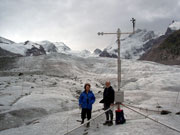 |
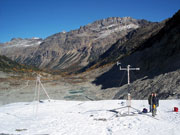 |
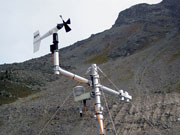 |
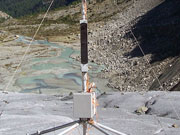 |
| A well-known climatologist and his wife inspecting the AWS in September 2004. The station stands freely on the ice and sinks
with the melting surface. J.O. |
Looking down-glacier. A tripod drilled into the ice with a sonic ranger forms an integral part of the AWS. It measures the distance to the surface.
J.O. |
A close-up of the instrument bar. Here sensors for windspeed, wind direction, radiation (solar and longwave), temperature
and humidity (aspirated) are mounted. J.O.
|
The AWS has a small solar panel. Two boxes contain a battery and a Campbell CRX10 data logger. Data are
sampled every 2 minutes and 30-min averages are stored. J.O. |
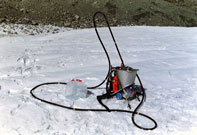 |
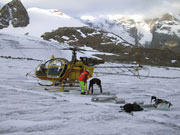 |
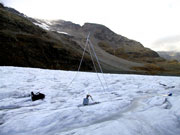 |
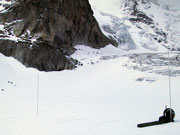 |
| Aluminum stakes used for mass balance measurements and mounting of the sonic ranger (SR) are drilled
into the ice with the Heuke-steam drill. With this drill it takes about 15 minutes to drill a 8 m deep hole. J.O. |
Helicopter support is relatively cheap because the airport of Samedan is only a few minutes away. Here
material is delivered for the AWS on the Perschgletscher. Photo by W. Boot. |
Different devices for mounting the SR have been tried. The tripod performs best, but is damaged
sometimes by the creeping snowpack. Note the logger box on the small tripod, standing freely on the ice surface (buried in winter). Photo by W. Boot.
|
Mass balance stakes just below Piz Palue, close to the equilibrium line. Photo by M. Bolder. |
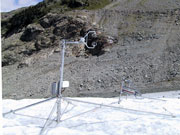 |
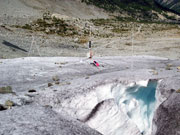 |
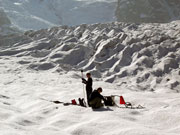 |
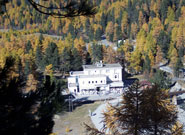 |
| During one year continuous turbulence measurements were performed at the AWS site on the glacier snout. The aluminum box contains
a logger and batteries. It has a solar panel on the top. Photo by L. Klok. |
Sometimes the glacier tries to eat the AWS. During the past ten years the station has been moved four times over small distances. J.O. |
Placing of a simple GPS unit on a 8m aluminum stake. The GPS measures position with a modest accuracy, but can operate automatically
for one year. J.O. |
The Landgasthof Morteratsch at the beginning of the Morteratsch valley. Here is also a stop of the Bernina railway, connecting
Sankt Moritz with Tirano (Italy). The beer on the terrace tastes very well after working on the glacier. J.O. |











